
Marriott organizational culture integrates the following five key elements: 1. People-first approach. Putting people first is Marriott’s top priority. The company believes that by taking care of its employees, they will in turn take care of customers. This commitment is evident in Marriott’s many employee-focused programs and initiatives, such as its tuition reimbursement program, its employee assistance program, and its diversity and inclusion initiatives. 2. Pursuing excellence. Pursing excellence is another core value that is integrated within Marriott organizational culture. The company sets high standards for its employees and encourages them to continuously strive to improve. This commitment to excellence is reflected in hotel chains many awards and accolades. These include recognition as one of Fortune’s 100 Best Companies to Work For and one of Ethisphere’s World’s Most Ethical Companies. 3. Acting with integrity. The largest hotel chain in the world expects its employees to be honest, ethical, and fair in all their dealings. This commitment to integrity is reflected in Marriott’s code of conduct and its many policies and procedures designed to promote ethical behaviour. 4. Serving the world. Marriott International declares its commitment to making a positive difference in the world. The company supports a variety of charitable organizations and encourages its employees to volunteer in their communities. Marriott also has a number of sustainability initiatives in place, such as its commitment to reducing its environmental impact and its investment in renewable energy. 5. Embracing change. The company understands that change is essential in the hospitality industry, which is constantly evolving. Marriott is committed to staying ahead of the curve and adapting to the changing needs of its customers. This commitment is evident in the company’s willingness to invest in new technologies and its focus on innovation. Marriott International Inc. Report contains the above analysis of Marriott organizational…

Marriott organizational structure had to change significantly with new executive appointments early in 2023. Following the departure of company’s president Stephanie Linnartz to become president and CEO of Baltimore-based sports equipment company Under Armour, Anthony Capuano became Marriott’s President and CEO[1]. Marriott International has a hybrid organizational structure that combines elements of both a matrix and functional structure. The company’s matrix structure is evident in the combination of functional and divisional configurations. Marriott has functional divisions such as marketing, sales, and operations, but it also has divisional units organized by geographic region. This allows the largest hotel chain in the world to achieve both global uniformity and local diversification and responsiveness. Marriott Organizational Structure The matrix structure works in conjunction with a regional structure, with each region having its own functional divisions. For example, the Greater China region has its own marketing, sales, and operations divisions. This allows Marriott to tailor its operations to the specific needs of each region. Marriott’s organizational structure is also characterized by a high degree of centralization. The company’s CEO and executive team have a significant amount of authority over decision-making. This centralization allows Marriott to maintain a consistent brand image and service quality across all of its properties. Marriott International’s hybrid organizational structure has several advantages. The matrix structure allows the company to achieve both global uniformity and local diversification and responsiveness. The regional structure allows the hotel chain to tailor its operations to the specific needs of each region. The centralization of authority allows the company to maintain a consistent brand image and service quality across all of its properties. However, there are also some potential disadvantages to Marriott organizational structure. The matrix structure can be complex and time-consuming, and it can lead to conflict between functional and divisional units. The centralization…
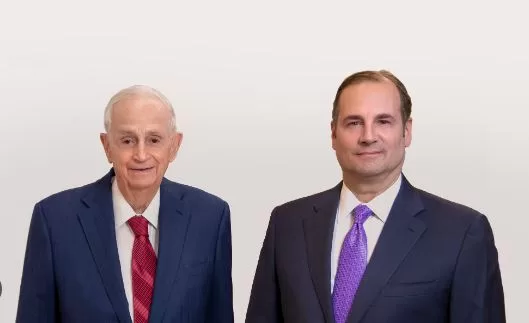
The current CEO of Marriott International is Anthony Capuano. He has been with the company for over 25 years and has held a variety of leadership positions, including Chief Development Officer and President of Global Development. Capuano is known for his strategic thinking and his ability to build and lead high-performing teams. Marriott International‘s leadership team is also notable for its diversity. The company’s executive team includes women, people of colour, and representatives from all over the world. This diversity of experience and perspectives helps Marriott International to better understand its customers and to develop innovative products and services. In terms of leadership style, Marriott is known for its commitment to servant leadership. Servant leaders focus on serving their employees and customers, rather than the other way around. This approach has helped Marriott International to create a positive work culture and to build strong customer relationships. Marriott International has a leadership development program called Voyage. Voyage is a 12-18 month program that is available to recent university graduates and provides a combination of practical hands-on experience and leadership training. Participants in the Voyage program rotate through different departments within a Marriott hotel and receive training from experienced leaders. Upon successful completion of the program, participants are well-positioned for leadership roles within hotel chain. Furthermore, Marriott leadership practices integrate the following important elements: Focus on employee development. The largest hotel chain in the world invests heavily in employee development and training. The company believes that its employees are its most valuable asset, and it is committed to helping them succeed. Fostering the culture of innovation. Marriott encourages its employees to be innovative and to come up with new ideas. The company has a number of programs in place to support innovation, such as its “TakeCare” program, which allows employees to submit ideas for improving the company.…

Fundamental Analysis of Marriott Stock Fundamental analysis refers to the practice of using financial activity to forecast stock prices. The following table illustrates main financial ratios for Marriott International: Ratio Marriott International performance Price-to-Earnings (P/E) Marriott’s P/E ratio is currently 22.4, which is slightly above the average P/E ratio of the S&P 500 index (18.6). In other words, Marriott’s stock is currently trading at a premium to the broader market Price-to-book (P/B) Marriott’s P/B ratio is currently 3.2, which is above the average P/B ratio of the S&P 500 index (2.3). This can be interpreted as Marriott’s stock is currently trading at a premium to the broader market based on its book value. Enterprise value to earnings before interest, taxes, depreciation, and amortization (EV/EBITDA) Marriott’s EV/EBITDA ratio is currently 11.5, which is in line with the average EV/EBITDA ratio of the hotel industry (11.0). This suggests that Marriott’s stock is currently trading at a fair valuation relative to its peers. Debt-to-Equity Ratio Marriott’s debt-to-equity ratio is currently 1.2, which is considered to be a healthy level of debt. In other words Marriott is well-positioned to manage its debt obligations. Return on Equity (ROE) and Return on Assets (ROA) Marriott’s ROE and ROA are both above the average ROE and ROA of the hotel industry. This suggests that Marriott is a profitable company that is generating good returns on its equity and assets. Marriott International main financial ratios Overall, Marriott’s financial ratios suggest that the company is well-managed and financially sound. Technical Analysis of Marriott Stock Technical analysis is the reliance of historical stock price activity to predict future price activity. Short-term trend The short-term trend for Marriott International is neutral. The stock is currently trading in a range between USD 198.23 and USD 206.55. A…

Marriott business strategy consists of the following 3 elements: 1. Pursuing asset-light business model. Operating in light-asset manner is one of the cornerstones of Marriott business strategy. Under this model, Marriott focuses on managing and franchising hotels, rather than owning them. This allows the hotel chain to expand rapidly and efficiently, without having to invest heavily in real estate. Light-assed strategy provides the company with a range of substantial advantages such as reduced capital investment and as a result, increased flexibility to enter into new markets and experiment with new brands. Furthermore, this strategy reduces exposure to the risk of real estate market downturns. 2. Growth through acquisitions. Marriott International has been a major user of acquisitions to fuel its growth. In 2016, it acquired Starwood Hotels & Resorts Worldwide in an USD 13.6 billion deal, which made it the world’s largest hotel company. The acquisition added nearly 1,300 hotels to Marriott’s portfolio, including brands such as Sheraton, W, and Westin. Since the Starwood acquisition, Marriott has continued to make smaller acquisitions to expand its reach into new markets and segments. For example, in 2017, it acquired Delta Hotels and Resorts, which added 38 hotels in Canada to its portfolio. In 2022, it acquired Hoteles City Express, which added 152 hotels in Mexico, Costa Rica, Colombia, and Chile. 3. Focusing on bleisure travellers. Bleisure travelling, a portmanteau of “business” and “leisure”, refers to the trend of business travellers extending their trips to include leisure activities. Marriott International is increasing its focus on bleisure travellers as part of its long-term business strategy. Up to date, this new customer segment, the business traveller who wants more choices for accommodations, that new blended traveller, and younger travellers who want more space for their travels, have been mainly served by Airbnb and…
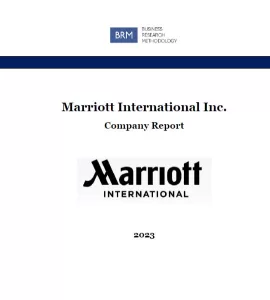
Marriott International is a worldwide operator, franchisor, and licensor of hotel, residential, timeshare, and other lodging properties in 138 countries and territories under 30 brand names. Started as a root beer stand in 1927 in Washington D.C., USA, Marriott has grown into the largest hotel chain in the world. For the full year 2022, gross fee revenues totalled USD 4.1 billion, a significant increase of more than 50 percent compared to 2021. Adjusted EBITDA reached nearly USD 3.9 billion in 2022, up almost 70 percent year over year. Full year adjusted diluted earnings per share (EPS) more than doubled from 2021, totalling USD 6.69. In 2022, Marriott International grew from 7,989 properties (1,479,179 rooms) at year-end 2021 to 8,288 properties (1,525,407 rooms) at year-end 2022, reflecting gross additions of 394 properties (65,376 rooms) and deletions of 94 properties (19,079 rooms), including the impact of the Company’s decision to suspend its operations in Russia. Marriott business strategy integrates pursuing asset-light business model and growing through acquisitions. Moreover, the largest hotel chain in the world focuses on increasing customer segment known as “bleisure travellers”. CEO Anthony Capuano and senior management pursue servant leadership style and the hotel chain has a hybrid organizational structure that combining elements of matrix and functional structures. Marriott International Inc. Report contains the application of the major analytical strategic frameworks in business studies such as SWOT, PESTEL, Porter’s Five Forces, Value Chain analysis, Ansoff Matrix and McKinsey 7S Model on Marriott. Moreover, the report contains analyses of Marriott’s business strategy, leadership and organizational structure and ecosystem. The report also analysis marketing strategy, ecosystem and discusses the issues of corporate social responsibility. 1. Executive Summary 2. Business Strategy 3. Marriott Stock Performance Analysis 4. Leadership 5. Organisational Structure 6. Organizational Culture 7. Marriott and Ansoff Matrix 8. SWOT Analysis…
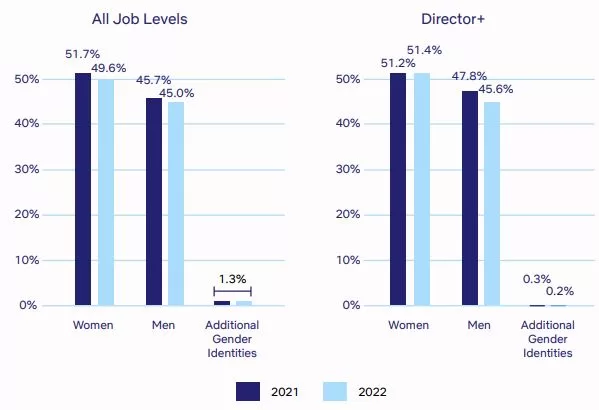
Netflix CSR Programs and Initiatives Netflix Supporting Local Communities The entertainment services provider maintains employee giving program that provides a 2:1 match on employee donations. As part of the program the company and employees donated USD34 million to over 5,000 charities worldwide Netflix and Gender Equality and Minorities 49,6% of Netflix employees are women 50% of US workforce are from historically excluded ethnic and/or racial backgrounds Netflix Fund for Creative Equity helps to create opportunities within the entertainment industry for minorities and historically under-represented groups Figure 1 Global Gender Identities at Netflix for 2022 Energy Consumption by Netflix In 2022 the company completed energy efficiency audits at its major facilities across North America The entertainment services provider uses 100% renewable electricity in all offices and productions it directly manages Carbon Emissions by Netflix Netflix is committed to reduce carbon emission by 50% by 2030 compared to 2019 baseline The entertainment services provider uses clean technology on over 60% of productions it manages directly In 2022 about 50% of the productions Netflix managed incorporated clean mobile power solutions such as grid tie-ins, mobile batteries, battery-hybrid generators, and hydrogen power units, resulting in fuel reductions that lowered emissions by 1,179 MTCO2e The company uses at least one electric vehicle (EV) on screen on all of its directly-managed productions The streaming service supports creators who choose to incorporate sustainability into their storytelling Figure 2 Netflix carbon footpring by business activity in 2022 Netflix and Sustainable Sourcing The company spent about USD 700 million with underrepresented suppliers in 2022 Governance Practices Netflix is beginning a phased declassification of its board in 2023. Starting from 2025 each board member will stand for annual elections The company is eliminating supermajority voting provisions in its articles of incorporation and bylaws The streaming…
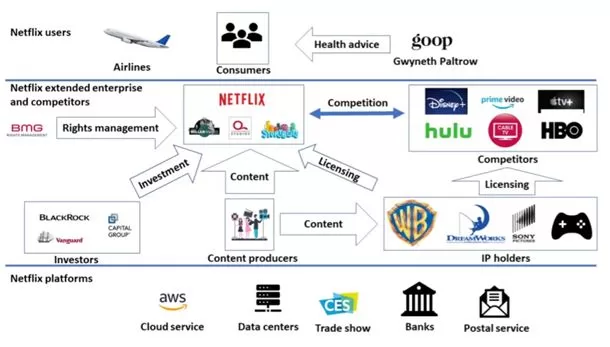
An ecosystem is a network of components (products, services and platforms) that depend on each other and fuel each other to jointly deliver greater value. Netflix ecosystem comprises the companies it owns, content producers, competitors, customers, as well as, investors. Moreover, assisting infrastructure such as AWS cloud service, data centres, trade shows, banks and postal service are also components of Netflix ecosystem. All of the entities listed above are considered elements of ecosystem, because they contribute to the survival and well-being of the ecosystem. Netflix ecosystem Development of business ecosystem can be divided into four stages[1]: 1. Pioneering stage is where ecosystem is formed. For video streaming ecosystem pioneering stage is the second half of 2000s. Netflix invented DVD rental business model and it is one of the first companies that offered online video streaming service. Hong Kong based iTV was the company that introduced online video streaming for the first time, but Netflix was the first company that perfected this business model and made it successful. 2. Expansion stage. Currently, Netflix has 231 million paid memberships in over 190 countries with offices in over 25 countries.[2] The rapid expansion of the company during the last decade caused the expansion of online streaming ecosystem in general, motivating media companies to launch their own rival streaming services such as Disney+, HBO, Hulu and others. 3. Authority stage is when an ecosystem matures. It can be argued that Netflix ecosystem is approaching its authority stage with the global marketplace becoming highly saturated with international, as well as, local on-demand media providers. The video entertainment industry is becoming ready for yet another disruption. 4. Renewal or death stage. It is hard to estimate the time when Netflix ecosystem is going to be renewed or if it is going to cease to exist altogether…
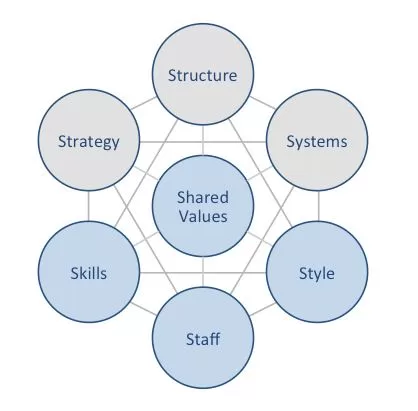
Netflix McKinsey 7S model shows how seven elements of businesses can be aligned to increase the overall effectiveness. According to the framework strategy, structure and systems are hard elements, while shared values, skills, style and staff represent soft elements. McKinsey 7S model stresses the presence of strong links between elements in a way that a change in one element causes changes in others. As it is illustrated in Figure 6 below, shared values are placed at the core of Netflix McKinsey 7S model. This is because shared values guide employee behaviour with implications on their performance. McKinsey 7S model Hard Elements in Netflix McKinsey 7S Model Strategy Nvidia business strategy relies on focusing on revenues maximization over membership growth and investing in original content. The entertainment services provider considers its globally successful original content such as House of Cards (2013-2018), BoJack Horseman (2020) and Squid Game (2021) as its unique selling proposition amid intensifying competition. Moreover, the largest streaming service in the world stays away from news and live sports segments, sticking to movies, series, documentaries and games, as part of its business strategy. Structure Netflix organizational structure is flat and unitary. There are considerably less management layers considering the size of the company and scope of its operations comprising 12500 people in offices in over 25 countries.[1] As a result, the flow of information is fast at the on-demand media provider and this contributes to the flexibility of the business to external macroeconomic changes. Systems There is a wide range of systems and processes that are important for the largest streaming service in the world to sustain its business. These systems include employee recruitment and selection, team development and orientation, transaction processing, customer relationship management, business intelligence, knowledge management and others. Furthermore, the system of…
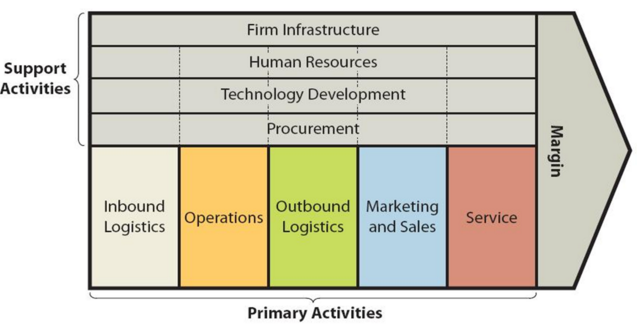
Value chain analysis is an analytical tool that can be used to find business activities that can create value and competitive advantage to the on-demand media provider. Figure below illustrates the essence of Netflix value chain analysis. Netflix Value Chain Analysis Netflix Primary Activities Netflix Inbound logistics Inbound logistics involves the processes associated with receiving and storing raw materials to create output. For a streaming service such as Netflix content is the raw material. Establishing strategic relationship with content producers and intellectual property holders such as Warner Brothers, Dream Works and Sony Pictures are the main sources of inbound logistics value creation for a streaming business. Netflix is utilizing these sources extensively. Currently, Netflix is increasing investments to produce its own, original content such as Squid Game, BoJack Horseman and Stranger Things as a differentiator amid intensifying competition. This shift has certain implications on inbound logistics aspect of the business. Specifically, focus on original content requires greater involvement in inbound logistics for the largest streaming service in the world. Netflix Operations Operations are the stage where inbound logistics are transformed into outbound logistics. For Netflix, operational efficiency and cost advantage are the main sources of value creation at this stage. The on-demand media provider has to maintain its video streaming platform effectively in terms of ease of access, quick search, stability, and security of the server. Netflix Outbound Logistics Outbound logistics refer to the distribution of products and services to customers. Usual sources of value creation in outbound logistics include Delivering to consumers directly without intermediaries, Cooperation with other businesses to share distribution costs and extensive integration of information and communication technologies. Considering that Netflix delivers digital media through streaming and downloads, the relevance of outbound logistics aspect of value chain analysis for the largest streaming service in…
